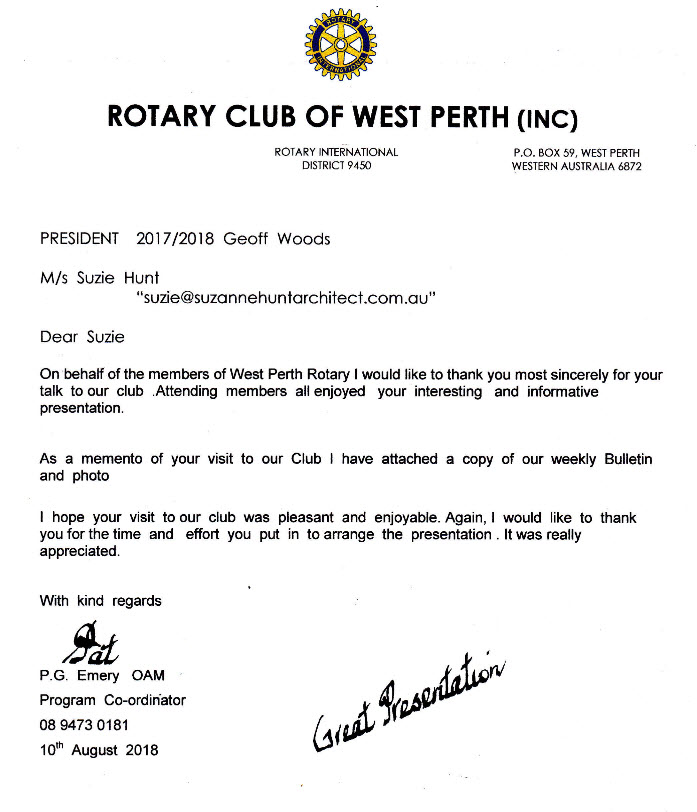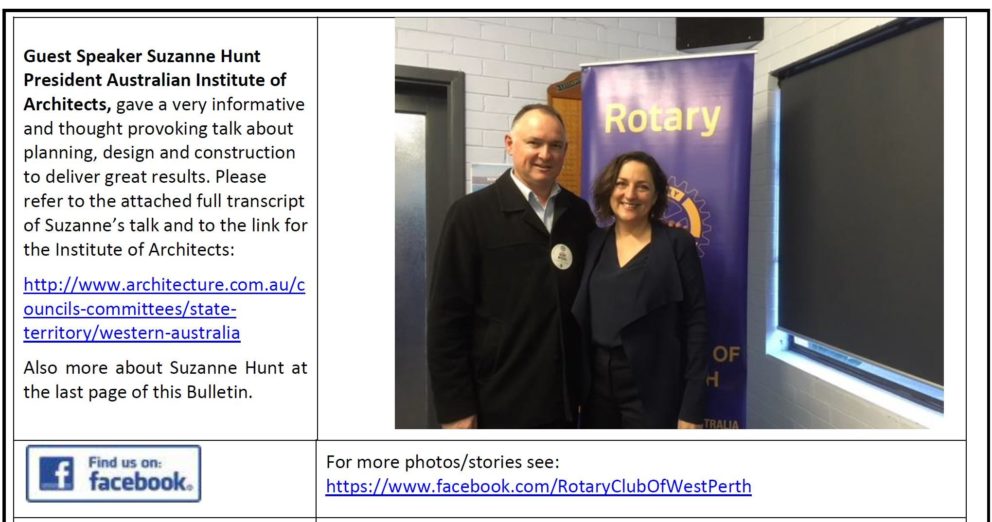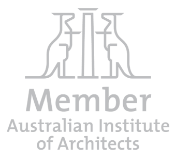Rotary Speech, Thursday 9 August 2018
Good morning everyone and thank you Pat sincerely for the invitation to talk today about the importance of Design and Construction to deliver great results.
I would like to acknowledge the traditional custodians of the land we are meeting their elders, past present and emerging.

But first who am I and why am I here. As the first female president of the WA Chapter of AIA, I came to this volunteer role from a less traditional career background than some of my predecessors. But like many women my age in the their mid 50’s my 30+ year professional career trajectory has been non-linear. At times it has stopped, then started, spluttering along as I had my four children now aged 22 to 16, including 20-year old twins. Albeit I knew what I was getting into as my late father was architect Peter Hunt. I have practised architecture in WA and the UK, worked in private practices, in state and local government agencies, and since 2004 run my own boutique architecture and interior design practice Suzanne Hunt Architect.
For the past 8years, I have sat as a non-executive board member at the Rottnest Island Authority, and for the last 4years I have sat on the WA Chapter of the Institute, the last two as President
My mandate when elected was essentially two fold. Firstly I wanted to disassemble the reputation of the Institute as a boys club and that of architects in general as arrogant creatives who never listened to their clients and always caused budget blow outs.
Secondly, I wanted the Institute to became more vocal in advocating for the value of good design and the important role that architects have in this discussion. Essentially my aim has been to make the Institute, architects and architecture more accessible and approachable, more relevant to our members, government representatives, the guy in the street through a sustained and targeted media presence and continued engagement within the community and government.
Good design is so important as it not only has a positive impact on the direct users of our built environment, but the community more broadly, the environment and the planet. Good design will also save you money, on running costs, and maintenance over the long term. Essentially, good design is good for you and for our community. Good design is a result of sound procurement and planning processes and of course collaboration with other built environment professionals,
At the Institute, we are committed to working closely with our construction industry colleagues and peers, so we can collectively improve built environment outcomes. We are acutely aware that architects and builders couldn’t excel at their respective professions without each other. It is a symbiotic relationship.

Last year we partnered with the MBA and Consult Australia, as well as the Association of Consulting Architects, to advocate for improvements to government procurement methods in WA to develop a joint submission for the Special Inquiry into Government Programs and Projects headed by John Langoulant. The report which quoted our joint submission was tabled in Parliament by the Premier in February this year.
As I’m sure you’re aware, procurement of government building projects is a major issue in WA, and procurement methods and their associated contractual arrangements have a direct impact on the final quality of design and construction. We are very keen to effect policy changes that will deliver better built outcomes.
To that end, we’d like to see government – at state and local levels – acting as a ‚Äòmodel client’. That means prioritising design and the expertise of architects as the lead design consultants, instead of many recent contractual methods that novated architects to head contractors such as the PCH experience.
That arrangement has the, perhaps unintended, consequence of relegating design to a line item that can be “value managed” out of the delivery program, to satisfy short-term concerns about upfront costs.
We as architects argue that design is a whole-of-life approach to a building and its occupation and use, and good design can save money over the long term. It’s a case of investing up-front to reap the financial, social and environmental rewards of good design later.
As a profession, architects are collaborative team players who bring a unique set of design-thinking skills to what is an increasingly complex and challenging construction industry. Construction is the third largest sector in WA at present, and it generates about 8% of gross state product (GSP).
Admittedly, the industry has suffered a downturn in recent years, but we at the Institute see this as a good time to prepare for the next upswing in activity, by getting the basics right for the future. Especially the definition of “Value for Money” for local and state government projects.
The NSW government have recently adopted a new 10-point Government Action Plan advocated by Multiplex’s MD John Flecker. The plan outlines steps the construction industry can take to enhance the delivery of value-for-money projects in the future.
In the plan, the NSW government acknowledges that value-for-money doesn’t necessarily equate to the lowest price for every project; instead it relies on the adoption of, and I quote:
“a broader, longer term view about the need to drive quality, innovation and cost effectiveness by fostering a thriving and sustainable construction sector” in the state.
That’s an approach that we as architects would like to see underpinning the procurement of built projects in Western Australia as well.
The NSW plan suggests that new construction projects should be procured and managed in a more collaborative way, using approaches such as Early Contractor Involvement. ECI places equal emphasis on design quality, cost effectiveness and high-quality build standards. These benchmarks are established early in the process and then carried through to the final result.
The plan also advocates the adoption of:
partnership-based approaches to risk allocation;
the use of standardised contracts and procurement methods;
the development and promotion of a transparent pipeline of projects;
and measures to reduce the cost of bidding, among other objectives.
I believe architects have a significant role to play in this shift towards a correctly defined value-for-money focused future for our industry.
With our 5yrs of university education, a further two years of study for registration, mandated Professional Indemnity insurances and continuous professional development, architects are the industry’s lead design professionals. To arrive at a final design solution, architects weigh and balance many often-competing concerns within an agreed budgetary framework to produce beautiful outcomes. But it is perhaps the little understood design thinking quality where we truly bring value to the process. The ability to explode the brief, identify unique opportunities and offer innovation. The ability to delight. I concede that, as a profession, we need to get better at explaining the value of what we do.
Of course we do not work in isolation we work as part of a project team alongside planners, landscape architects, surveyors, quantity surveyors, engineers, builders, sub-contractors and suppliers. We all have crucial roles to play in this quest to deliver buildings and spaces that are great to inhabit, and projects that look beautiful and provide value for money for our clients.
Our city and the extensive metropolitan area is currently undergoing a major transformation from a predominantly suburban low-density typology towards a denser, more public transport orientated development pattern.
Achieving that vision relies heavily on urban infill and diverse housing solutions, an area where architects excel at producing innovative solutions. However, Western Australia’s current statutory planning system is struggling to keep up with the pace of this change.
Issues of affordability, a natural resistance to change, and a local government planning system that is increasingly under resourced, only serve to exacerbate the current problems with the planning system.
It’s not an over-statement to say, the development industry – including developers, architects, planners and contractors – are frustrated by red-tape, and slow and inconsistent approvals processes. In that respect, the time is ripe for change.
To that end, the Institute has been an eager and willing participant in recent planning system reforms, and we are currently lobbying for architects to be represented on major strategic planning committees that will shape the future of the city for years to come. As an aside it astounds me that the Metronet Taskforce has not one design professional but does have REIWA representatives and traffic engineers.
I’m sure you’re aware that the current predictions for Perth’s population in 2050 sit between 3.5 and 4.4 million people. At the higher end, we would find ourselves living in a city with a population equal to that of Melbourne’s today. In order to plan for smart and sustainable growth, good design must be at the forefront of any new development.

It’s no longer satisfactory, to continue to build more and more subdivisions on Perth’s urban fringe -there is a cost of such urban sprawl and it’s mainly borne by those residents who face barriers to accessing services that people living in the inner and middle ring suburbs take for granted. We as a community need to become much more considered about how and where we build, and that’s exactly where the importance of good design comes into play.
In respect of future proofing the planning of our cities, our members have been actively involved in the development of the governments policy called Design WA . This suite of instruments, including a new planning policy, apartment design guidelines, landscape design guidelines, design review panels to assess proposed projects, and design skills training – all aim to lift the quality and guide the development of medium and high-density apartment buildings.
When Design WA was first mooted four years ago, it garnered bi-partisan support from both sides of politics, and its rigorous and lengthy consultation process with the entire development and construction industry was heavily scrutinised, subjected to feedback, and modelling – in turn generating significant, buy-in from all quarters. The resultant policy will serve our industry – and importantly, the people of Western Australia – well into the future.
Some local government authorities are already using its component parts to great effect, as are design review panels. It was expected that the policy suite would be rolled out in July however, disappointingly, things have stalled.
Late last year, Minister Saffioti, appointed independent reviewer Evan Jones to undertake a broader review of current planning policies in WA. Mr Jones’ remit was to introduce a framework for strategic-led planning by overhaulling and updating the existing planning system – which we agree is unnecessarily cumbersome and onerous – to make it more legible and efficient.
Naturally, the Institute supports these broad scale reforms, but it seems that the many positive initiatives embodied in Design WA appear to be watered down or even shelved as part of this latest review. Needless to say no one is quite sure when or even if Design WA will now be rolled out.
Earlier this week, the Institute submitted its response to the Green Paper, where we identified our key concerns and provided 12 recommendations. By far our greatest concerns is that under the Green Paper, design is viewed as a secondary consideration to planning; an afterthought if you like.
However, as I’ve outlined, we argue that good design must be at the forefront the planning process for several good reasons.
Given that we are grappling with the delivery of increasingly complex projects, it’s essential to involved design experts to:
Optimise yield, whilst progressing innovative concepts, which include high quality planning, urban design, landscape and architectural built form quality;
Ensure diversity by providing a range of dwelling types and sizes to attract a diverse range of households and socio-economic groups, including affordable housing;
Provide a unique and high-quality public realm, including streetscapes, which support pedestrians and cyclists based on evidence-based site analysis, which yield site specific solutions;
Integrate diversity including employment and innovation clusters to support a successful growing economy, employment, services and infrastructure;
Integrate transport solutions, which are intermodal and woven into the public realm;
Deliver developments that are market-responsive by being planned with inbuilt flexibility to respond to changing market conditions over time;
Demonstrate environmental leadership by utilising correct solar orientation for master-planning and individual buildings, which also reduce energy, water, minimise waste, protect biodiversity and ultimately reduce maintenance and ongoing costs to the end user; and
Guarantee liveability by delivering high levels of functionality and amenity for intended residents, employers, workers and visitors alike.
Recent delays have hampered that reform agenda, but we as a profession are committed achieving these much-needed changes, which will benefit the community and have an enormous impact on the shape and functionality of our cities and towns for the next two generations at least. We are keen to continue working with government to ensure that design and planning are seen as intrinsically linked, as we seek to create a smart and sustainable future for our children and grandchildren.
You only need to look at the range of projects that received accolades at the Institute’s and MBA’s annual awards programs to see the positive impact that architects and builders are having on our built environment at every scale – from small houses in the suburbs to large apartment developments, and from tiny insertions like the Cadogan Song School to major city-defining projects such as Optus Stadium.
Design is an important and essential part of the construction process, and the delivery of great built projects starts with good design and good procurement. We look forward to continuing this important conversation about the future planning and design of Western Australia’s cities and towns, and to contributing our skills and experience to maintain liveability while we make our built environment smarter and more sustainable.
In closing, I would like to briefly touch on unconscious bias as part of the ongoing discussions around gender and diversity in the design and construction professions. We all experience unconscious bias, it creeps into so many of our assumptions and decisions at work.
I believe that it’s important for all of us, but especially those of us that are employers or manage teams, to be aware of how it can impact the workplace, from recruitment to hiring; team dynamics to career development; diversity of thought and even innovation.
For example in the construction industry to achieve beautiful functional buildings that are genuine community assets, we need to include input and contributions from people whose backgrounds and beliefs reflect the diversity of our society.
This is not just an issue of having more women in the construction industry, either; it’s about being inclusive of the different perspectives that exist in our cities – whether it be gender, colour, ethnicity, religious beliefs, age, parental status, or sexual orientation. It is this diversity which make our communities so rich and rewarding.
In a practical sense, I think we all need to venture outside our comfort zones and make an effort to seek out diversity when we are interviewing and selecting staff, board or committee members for example.
It’s not enough to say you can’t find say a woman to interview for a position. If you can’t, why not, and where are you looking? Women make up 50% of the population and at least 55% of university graduates these days.
I really appreciate that Pat Emery looked outside the box to find me and invite me to come and talk to you all today. Thanks Pat.
In closing, I would like to reiterate that at the Institute, we appreciate the importance of the symbiotic relationship between architects and builders. Our designs could not be realised without the essential skills and experience of our builder colleagues, who take great pride in their ability to construct our vision and deliver great results for the community.
Thank you everyone for your time this morning.
I can take a few questions.


